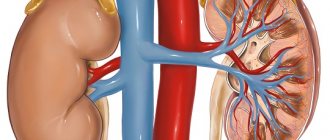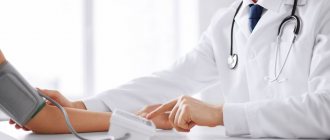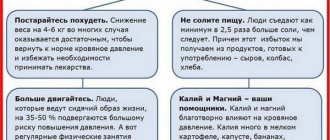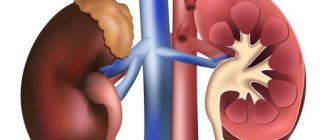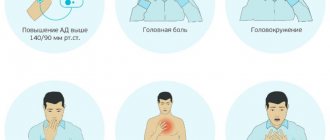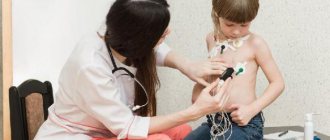For hypertensive patients, it is not news that when measuring pressure the lower reading reaches 100. There are many reasons for this phenomenon.
Most often, a heart pressure of 100 indicates problems with the vascular system. As a rule, an increase in blood pressure can be explained not only by vascular diseases, but also by high levels of cholesterol and blood sugar.
With a systematic increase in lower pressure, one can argue that there is a violation of blood flow in the kidneys and adrenal glands.
Diastolic pressure above 100 may also indicate other serious problems in the body. Failure to see a doctor in a timely manner increases the risk of developing a microstroke, stroke, and myocardial infarction.
Changes in blood pressure can be observed by such signs as noise in the head, dizziness and fatigue. Today, these problems are often faced not only by representatives of the older generation, but also by young people.
When the upper pressure is normal, and the lower reaches 100 or higher, you should know how to act in such cases and what needs to be done.
What does diastolic pressure 100 mean?
Diastolic heart pressure is one of the most important values by which a person’s general condition can be assessed.
This indicator is formed based on the calculation of the volume of blood ejected by the heart, vascular resistance, as well as their conductivity. Diastolic hypertension is often accompanied by normal values of upper blood pressure.
For a healthy person, the norm is from 60 to 90 mm. Hg Art. If the lower pressure turns out to be 100, you need to know what this means. It can be noted with confidence that this fact indicates a disruption of the circulatory system.
When?
Blood pressure depends on many factors: time of day, a person’s psychological state (pressure increases during stress), taking various stimulants (tea, coffee, amphetamines) or medications that increase or decrease blood pressure.
People sometimes have a “fear of white coats” when measuring blood pressure. A rise in pressure at the time of measurement occurs due to stress, which sometimes occurs when visiting a doctor or when a nurse appears. What causes inaccuracy in blood pressure measurements?
In healthy people, the level of diastolic pressure fluctuates within 65±10 millimeters of mercury.
Why does lower blood pressure increase?
High blood pressure clearly indicates the presence of problems in the body. To normalize lower pressure readings, the values of which are off scale 100 mmHg. Art., it is necessary to identify the causes of this condition and eliminate them
In frequent cases, hypertensive patients have to deal with kidney and adrenal insufficiency.
During the diagnosis, other provoking factors are also considered:
- blood flow in the kidneys decreases, resulting in the formation of angiotensin II, which affects the increase in diastolic pressure;
- chronic inflammation of the kidneys, which causes the growth of the connective tissue of the organ;
- large body weight;
- chronic glomerulonephritis, which is an infectious-allergic disease (with the development of such a pathology, the connective tissues of the kidneys grow, resulting in compression of the blood vessels; in addition, there is active production of renin);
- absence or pathological development of the kidney;
- genetic disease - polycystic kidney disease;
- atherosclerosis, developing along with thrombosis, which entails a narrowing of the vascular lumen and disrupts the functioning of the kidneys;
- hormonal disbalance;
- protein and saccharides that accumulate in the kidneys.
As the lower blood pressure values increase, the upper values may increase. If deviations are found in only one parameter, then it is worth studying the problem comprehensively.
When the lower pressure reaches 100 or more, it is necessary to undergo diagnostics to clarify why this is happening, the main reasons, what to do and what treatment to take.
The main reasons for the increase in DBP
Increased lower pressure is multifactorial, there are reasons hidden inside the heart and blood vessels (only 20%), and there are extracardiac (80%). In addition, physiological and pathological triggers of elevated diastolic markers are distinguished.
| Causes | The essence of pathology |
| Physiological | |
| Long-term smoking abuse | Nicotine and tar provoke vasospasm, impaired blood flow, hemodynamics, and blood pressure increases. Since cigarette toxins primarily affect the lungs and kidneys, renal blood pressure (RBP) increases. |
| Alcohol | It works in a similar way, only instead of the lungs, the liver is involved in the process, metabolic processes are disrupted, the vessels either dilate or contract, hypertension increases, as soon as the body’s compensatory capabilities end, myocardial ischemia develops with infarction |
| Abuse of salt | More than 5 g/day leads to fluid retention in the body, hemodynamic disturbances, and an increase in DBP |
| Hyperload | Physical or mental stress stimulates the synthesis of catecholamines - this is a natural defense mechanism in which a person does not feel pain or fatigue, but against this background blood pressure rises rapidly, with the lower one overtaking the upper one |
| Stress | Vasospasm provokes an increase in blood pressure |
| Endocrine disruptions | Puberty, menopause, menstruation, pregnancy - cause hormonal changes in the body, change vascular tone, arterial markers |
| Pathological | |
| Myocardial ischemia | General hemodynamics and cardiac output are disrupted, DBP increases |
| Atherosclerosis | Reducing the lumen of arteries, capillaries, and veins due to atherosclerotic plaques impairs blood circulation and leads to an increase in diastolic indicator |
| Infringement of the arteries supplying blood to the brain | Causes ischemia of the brain, its centers, pathology of the musculoskeletal system, which increases the lower pressure to 100 units and above |
| Endocrine diseases: diabetes, hyperthyroidism, Cushing's syndrome | The balance of hormones in the body is disrupted, dopamine biologically active substances, thyroid hormones, stress hormones predominate, vascular spasm develops against the background of metabolic disorders, which causes an increase in vascular parameters |
| CRF, CKD (chronic kidney disease) | The synthesis of renin is disrupted, which leads to an imbalance in blood pressure control with the development of malignant hypertension, DBP is a marker of such a process |
| Post-stroke condition | Often a DBP of 100 units indicates a disruption in brain function, which occurs against the background of a stroke, requiring long-term correction |
Symptoms
It is worth considering the presence of hypertension if there is a systematic increase in lower blood pressure.
With this pathology, a number of symptoms arise:
- headache;
- pain under the shoulder blade and in the sternum area;
- rapid pulse;
- swelling of the face and limbs;
- nausea;
- noise in ears.
Due to the excess of lower blood pressure, cardiovascular blood flow is disrupted. As a result of this, the vessels are always in good shape and do not expand.
If timely treatment is not started, the disease will begin to affect vision and contribute to the development of chronic diseases.
Diagnostics
If a patient has a lower pressure of 100, then you need to determine what this means in a particular case.
To do this, you need to undergo a comprehensive diagnosis:
- biochemical and general blood test;
- ultrasonography;
- dopplerography of the head;
- ECG.
When the heart pressure reaches 100, the heart hurts; It is customary not to take medications for systematic treatment without consulting a doctor, but to track the values throughout the day and write them down in a notebook.
The dynamics of changes in indicators will be assessed by a qualified specialist.
How to reduce lower pressure if it is 100 or more
If alternative medicine does not give the required result (and blood pressure becomes higher), then you can start taking diuretics. Such tablets are allowed to be taken only after consulting a doctor.
Many of them help remove salt and potassium from the body.
Potassium is an important component; it helps the heart muscle contract. Diuretics should be taken additionally with potassium-containing drugs.
There are also diuretic tablets on sale that promote the accumulation of this component. Self-treatment with diuretics is not possible, since potassium deficiency and excess are dangerous for the body.
If in adults the lower pressure rises insignificantly (no more than 100 mm Hg), and this does not happen systematically, then the doctor may recommend taking antihypertensive drugs that can have a central effect.
Such drugs regulate the functioning of the sympathetic nervous system, as a result of which the number of vasoconstrictor signals decreases. Along with the upper pressure, the lower pressure levels also decrease.
When vascular spasm is relieved, lower blood pressure values decrease, for example, from 120 to 90 mm Hg.
To maintain normal blood pressure levels, the doctor prescribes special treatment with angiotensin-converting enzyme inhibitors.
Such ACEs take part in the production of substances - angiotensin 2, which constrict blood vessels. If necessary, therapy with such medications is carried out continuously.
If renal pressure is higher than normal, then angiotensin 2 receptor blockers may be prescribed. To keep blood pressure within normal limits, it is enough to take the drug once a day.
To achieve a stable result, the course of treatment should be at least one month. The main advantages of this medicine include a low risk of negative reactions in the body.
There are situations when blood pressure suddenly rises, and there is no suitable medication at hand. In this case, it is important to provide first aid correctly.
To do this you need:
- the patient should lie on his back in order to relieve excess stress on the chest;
- the person should unfasten constrictive clothing to improve breathing and open the windows;
- apply a cold compress to the back of the head;
- After 30 minutes, do a warming massage to restore blood flow.
If you experience severe heart pain when your blood pressure rises, you can take a nitroglycerin tablet.
Why is high heart pressure dangerous?
If a person constantly suffers from high blood pressure, he should know what and how to reduce heart pressure, because this condition is not safe. Increased blood pressure negatively affects the functioning of the body.
Doctors note the negative impact of this condition on the heart muscle. With increased pressure, serious changes occur in it. More often, pathology manifests itself in the area of the left ventricular myocardium (this area of the heart increases in size). In this case, the organ receives insufficient blood, which is dangerous for the development of ischemia.
Due to increased blood pressure, atherosclerosis develops. With this pathology, the walls of large vessels (arteries, veins) and small capillaries are affected. With this disease, doctors often diagnose kidney damage (nephropathy, renal failure).
High blood pressure also affects the brain. Hypertension can act as a provocateur of stroke and ischemia.
Hypertension also negatively affects the organs of vision (eyes). With high blood pressure, blood vessels thicken. This pathology is accompanied by hemorrhages inside the retina, which threatens blindness.
Important: Increased blood pressure in the early stages of pregnancy is considered dangerous. Severe vasoconstriction causes insufficient supply of oxygen and nutrients to the child. The physiological growth of the fetus may slow down. A strong increase in blood pressure can provoke spontaneous miscarriage.
Treatment
When your heart pressure is above 100, you need to know what to take and how to act to lower it.
To obtain a positive result, it is important to carry out complex treatment, taking into account the individual characteristics of the patient’s body and his age.
Based on the situation, the patient may be recommended one of the treatment methods - medicinal or non-medicinal. Each specific case requires a thorough study of the problem in order to correctly prescribe drugs.
Non-drug methods
Non-drug treatment involves following some important recommendations, namely:
- it is required to stop drinking alcoholic beverages and smoking;
- if necessary, you need to get rid of excess weight;
- It is recommended to exercise daily, performing simple gymnastic elements;
- you should try to avoid stressful situations and excessive physical activity;
- It’s worth eating with a proper diet.
With high blood pressure, proper rest is of no small importance. If the work is sedentary, you should take frequent breaks to perform therapeutic exercises.
All these recommendations will help normalize the lower pressure mark and keep it within acceptable limits.
Non-drug therapy also involves the use of herbal ingredients. For hypertensive patients the following will be useful:
- horsetail tincture;
- bearberry decoction;
- remedy from lingonberry leaves.
You can see if these herbal remedies help in just a couple of weeks. When using folk remedies, you should not hope for instant results.
Use of medications
If you cannot reduce the lower pressure, which has risen to more than 100 mm Hg. Art., through traditional medicine, it can be confidently knocked down with medications after doctor’s prescriptions.
If arterial hypertension occurs, the patient should take pharmaceutical medications.
They are divided into several categories:
- adrenergic blockers (to eliminate heart failure and treat vascular diseases);
- calcium antagonists (help in the treatment of heart disease);
- ACE inhibitors (lower blood pressure and expand the vascular lumen).
In order to normalize oxygen metabolism, the drugs Concor or Corvalol are often prescribed.
If the lower blood pressure readings do not exceed 90, then to prevent its further increase, you can take tincture of valerian or hawthorn.
Left ventricular hypertrophy
The development of cardiac left ventricular hypertrophy is based on a factor such as arterial hypertension, which provokes intense work of the myocardial ventricle. Due to hard work, the walls of the chambers increase, which after some time lose their elasticity and stop working normally.
With the development of left ventricular hypertrophy, cardiac functionality is impaired, which accompanies the appearance of unpleasant symptoms. Prominent among them are:
- dyspnea;
- dizziness;
- loss of consciousness;
- angina pectoris;
- tachycardia;
- fast fatiguability.
Cardiac left ventricular hypertrophy can be a symptom of serious pathologies, among which the most common are pulmonary edema, heart disease, atherosclerosis, heart failure, myocardial infarction and other diseases that can increase the size of muscle tissue.
The left ventricle is the connecting link that is responsible for supplying oxygen-rich blood to organs and tissues. Hypertrophy itself is not a fatal disease, but it can cause a number of dangerous pathologies.
- The heart is unable to pump enough blood, causing heart failure.
- Abnormal disturbances in the heart rhythm lead to arrhythmia.
- Insufficient oxygen supply to the heart and organs causes coronary heart disease.
- A short-term interruption in the blood supply to the heart provokes the development of a stroke.
- Sudden loss of heart function, breathing or consciousness can cause it to stop.
Because of the above possible complications of the disease, it is important to identify it in the early stages, before hypertrophy can provoke heart damage. To diagnose the disease, you need to consult a cardiologist.
Before treating left or right ventricular hypertrophy, it is necessary to determine the cause of the development of the disease, since health therapy is aimed at eliminating the main provocateur, in combination with therapeutic measures that stop pathological changes in the ventricle. By stopping the factors influencing the development of hypertrophy, treatment of the disease becomes very simple.
Forecast
If you take the necessary measures in a timely manner, you can normalize your blood pressure and achieve lasting results. True, there are situations when you have to take medications and herbal tinctures constantly.
To exclude serious health problems and receive the correct prescription, you should definitely visit a doctor and undergo the recommended diagnostics. In the worst case, there is a high risk of stroke or myocardial infarction.
Tips to normalize cardiac blood pressure
There are folk recipes and recommendations that will help reduce lower pressure if it reaches 100 or more.
How to reduce blood pressure, we will consider below:
- Corn flour tincture helps effectively. In the evening, pour a spoonful of this flour into a glass and fill it with hot water. The product should be infused overnight, after which it is filtered and taken throughout the day.
- Every day before meals you can eat a couple of cloves of garlic. You can lower blood pressure by taking a tincture of this ingredient. Pour boiling water over the garlic and leave for 6 hours. The finished medicine is filtered and stored in the refrigerator.
- Cranberry juice can reduce blood pressure readings. For greater effectiveness, it is recommended to mix it with flower honey, maintaining a 1 to 1 ratio. The course of treatment is two weeks, provided that the medicine is taken a teaspoon three times a day.
- A decrease in blood pressure occurs if you take a mixture of onions and honey. The proportions of ingredients and dosage are the same.
Elecampane is useful for hypertensive patients. By lowering pressure, it strengthens the walls of blood vessels and the myocardium. You will need the following ingredients: dried plant root, washed oats, honey.
The medicine is prepared according to the following algorithm:
- pour oats with water (500 ml), boil, leave for a couple of hours;
- dried plant roots (70 g) are crushed, poured with pre-settled decoction and boiled again;
- the prepared product is infused for another two hours;
- after straining, add honey, mix and drink three times a day before meals (the duration of the therapeutic course is on average two weeks).
Using these simple recommendations, you can keep your problematic blood pressure normal. If you take the medication daily, you won’t have to worry about the consequences of sudden surges in blood pressure.
